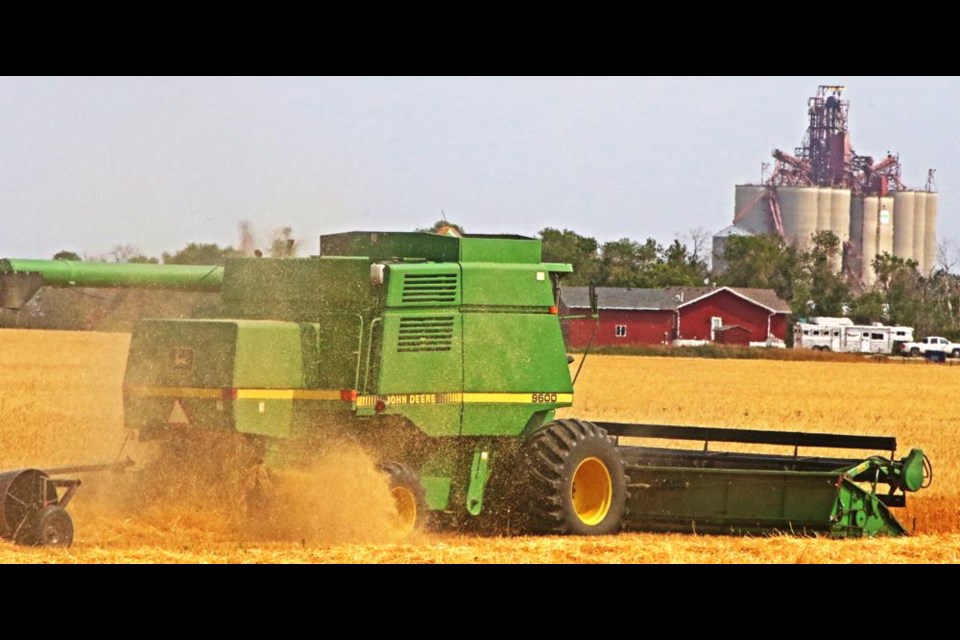WEYBURN - With harvest operations about 52 per cent done in the Weyburn region, and 21 per cent for the southeast as a whole, a series of thunderstorms moved through the region with hail on Wednesday evening, and heavy rain.
Area farmers reported varying amounts of rain and of hail, with some fields seeing as much as 100 per cent damage.
Dale Paslawski, who farms in the Cedoux area, said they received about 1.4 inches of rain, and hail stones, damaging crops and property.
“We were hit hard by ping pong and golf ball sized hail for 10 minutes, which broke five windshields and badly damaged metal on vehicles and our metal roof on the house and sheds. It also badly dented crops very badly over a large area, and we have some crops hailed out 100 per cent,” he said on Friday.
To the north and northwest of Weyburn, Dale Mainil said they received close to two inches of rain, and had some hail damage throughout their fields, “anywhere from 10 to 100 per cent. It was a bad storm.”
Further east, in the Creelman-Fillmore area, Marcel Van Staveren said they saw rainfall ranging from a half-inch to two inches, and while some hail fell, it didn’t do very much damage to their crops.
“We noticed very very little damage or yield loss from the few stones that fell,” he said, noting their hail was “wet” rather than dry hail, as in they received the rain first before the hail, and it dampened any damaging effects of the hail on their fields.
“We have become concerned with the ongoing rain every two or three or four days,” he said.
“Ongoing wetting and drying from rain have reduced the milling quality of cereal grains, such as wheat and durum, as it bleaches in colour from red or amber to a whitish colour. This deterioration will soon be evident with incremental rain already as produced by excess July heat without rain. We are seeing light test weighted wheat and durum, downgrading or discounting average or below average type yield,” said Van Staveren.
The Sask Ag crop reported noted some wide variances in harvest progress, depending on moisture conditions throughout the southeast. Some areas, such Estevan-Lampman-Redvers areas, only report seven per cent done while the Regina-Indian Head-Rouleau area is 16 per cent done, and Weyburn is furthest along at 52 per cent.
Within the southeast as a whole, 88 per cent of fall rye has been harvested along with 51 per cent of winter wheat. For spring-seeded cereal crops, 32 per cent of durum and oats are harvested, along with 29 per cent of barley, and eight per cent of spring wheat.
For pulse crops, 66 per cent of field peas, 49 per cent of lentils and 25 per cent of chickpeas are in the bin, and for oilseeds, mustard is 31 per cent completed, while canola is four per cent harvested.
Regionally, 40 per cent the fall rye is 1CW and 60 per cent 2CW, while winter wheat quality is reported at 39 per cent 1CW, 54 per cent 2CW, five per cent 3CW and two per cent as feed.
Topsoil moisture conditions continue to fall short within the region, excluding areas hit by the recent thunderstorms. Cropland topsoil moisture prior to the rain was 33 per cent adequate, 37 short and 30 per cent very short.
Hayland topsoil was 25 per cent adequate, 40 per cent short and 35 per cent very short. Pasture topsoil is 17 per cent adequate, 42 per cent short and 41 per cent very short.
Currently, 18 per cent of pastures are in good condition, 23 per cent are fair, 49 per cent are poor and 10 per cent very poor, and the recent rains may help improve conditions in some areas.




